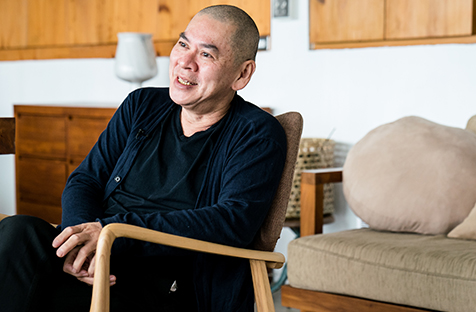
攝影|張鍾元、黃宏錡
《無無眠》蔡明亮大展
蔡明亮
首展日期|2016/03/26 - 2016/04/24
首展地點|國立臺北教育大學北師美術館
入圍理由
繼「來美術館郊遊」後,「無無眠」再次進入北師美術館,以更為簡潔布展形態呈顯「行者」系列兩部影片與〈秋日〉。毫無疑問,時間仍為蔡明亮作品最核心的思想。它是玄奘的緩慢步走、是冬夜的踟躕、是浸泡水中的謐靜。光影幻化之間,投映銀幕與館外市景交融。時間作為電影展覽的另一路徑,是引領觀眾走入展廳,坐臥躺觀賞動靜之間的聲影。於此同時,「無無眠」的啟示在於將美術館形構為融會大眾文化(歌手獻唱)與嚴肅文化(電影作為藝術)的交匯之處,更成為觀眾的沉睡之穴。(主筆/孫松榮)
關於《無無眠》蔡明亮大展
本展播放三部短片皆為蔡明亮近兩年全新創作。《西遊》與《無無眠》是「行者」系列短片的第六與第七部作品,李康生身穿紅色僧袍、光頭赤腳,以其獨特緩慢的速度行走在世界各地,彰顯一種失落已久的──唐朝玄奘徒步萬里西行取經的弘法精神。《秋日》是黑澤明御用場記、同時也身兼作家及製片人—野上照代女士的肖像錄。 本展覽採用極簡無裝置概念,讓影片作品中的城市影像和美術館原有的展場空間,在夜晚氛圍下緊密結合,並選用不同材料作為投影介質,紙糊屏幕的細微紋路與斑駁痕跡;金屬板如同賽璐璐般的通透質感,皆產生了不同的投影及觀看效果。為期四週的展覽舉辦了多場深夜講堂、音樂會及夜宿美術館活動,吸引眾多學生、民眾甚至親子家庭走進美術館,拓展了藝術參與及美感體驗的更多可能。
關於人物
繼2014年《來美術館郊遊》後,蔡明亮和國立台北教育大學北師美術館再度合作,以李康生穿僧袍於世界各地慢走長征之「行者」系列短片,《西遊》、《無無眠》,及以日本知名電影導演黑澤明御用場記、製片兼作家野上照代女士為主角的《秋日》,三部短片輪番播放,再次把電影帶進美術館。一個月的展期,蔡明亮淨空美術館,全無贅餘裝置,並調整美術館既定的開放時間,舉辦各式活動,甚至提供寢具讓觀眾通宵夜宿,打造不同以往的觀影體驗。
近幾年蔡明亮逐漸不拍劇情長片,更多聚焦於同一主題的短片,例如李康生的「慢走長征」系列。蔡明亮要求自己丟棄僵化規定以換取創作自由,從美學而非市場考量出發,重新思考電影還能做些什麼。無論剪輯、拍攝技術、故事情節或演員表演都仔細評估,用極簡的結構讓作品呈現行動理念。他說:「電影不只一種拍法,也不只一種看法。我們對電影媒材的概念其實麻木又僵化,但電影媒材這麼神奇,為何不好好用它呢」。蔡明亮質疑,為何談論電影只有紀錄片或劇情長片?為何拍電影非要先有故事?「現在,人們看電影都在討論劇情看不看得懂,刺不刺激,很少人在討論美學。大家老愛說電影是一門藝術,但怎麼可以沒有美學就成為藝術概念」。
自2013年長片《郊遊》之後,蔡明亮宣布將電影改到美術館展演,主因是企圖脫離市場取向的院線發行模式,將注意力轉回創作本身;「我其實不那麼愛拍電影,拍攝過程一堆麻煩事,老闆、觀眾、公司、影展各有各的要求,如果我是商業片導演早就被淘汰掉了,但因為我的作品屬性讓我生存下來。我很幸運能在電影院做幾乎不可能立足的事,但也更確定我的作品必須被放在恰當的通路上」。他愛電影但也質疑電影,電影院有固定座位,觀眾進去就是要刺激、娛樂與故事,但美術館是流動的,觀影距離或時間因人而異,兩者造就的觀影時空氛圍截然不同,尤其是「為期一個月的美術館檔期,或許能吸引比院線更多的觀眾前來觀賞,把根基紮的更深」。
北師美術館館長林曼麗相當支持蔡明亮的計畫,認為這樣的展演應當成為常態。兩次在美術館辦展,蔡明亮思索如何與館內既有建築裝置相結合。看美術館就像看一個人,每個人都特別,作品並非首位,時間到了就會挪開,就會卸除,美術館卻始終都在。在電影院放映,即便做足宣傳,票房卻只看上映前兩週;美術館展期長,且全國僅此一處,能做的嘗試反而更多。如同往常,蔡明亮依舊上街賣票行銷,親力親為邀請民眾走進美術館看他的電影。他讓美術館成為可以很放鬆、很好玩的地方,有歌手唱歌,有深夜講座,大家要躺要臥,要走要留,邊睡邊看電影都可以,將美術館轉化為同時能吸引文青與時尚年輕人的「潮」地帶,「要罵我或者跟我說看不懂我的電影都行,美術館就應該很自由;我不擔心觀眾不喜歡,我在意的是觀眾不進美術館」。蔡明亮認為電影只是手段,重點是讓人走進美術館,每個人在美術館都能自行組合觀賞順序,在淺移默化之中自然學習,去接受各形各色的表現形式。他認為「美學教育是當務之急,孩子從小就去美術館,心自然就柔軟開放了」,尤其是走進美術館,「總有人會被改變,但電影院幾乎不會改變什麼,改變了就賺不到錢,如果觀眾素質不改變,就沒有藝術創作甚至自由表達這些事」。
蔡明亮認為台灣觀眾稍嫌偏食,對「藝術片」敬而遠之,而這也是他積極上街面對面拉票的原因。因為北師美術館是學校單位,他在午餐時進校園拉票,但校區展覽通常是不賣票,他跟林曼麗說一定得賣票,理由不是為了賺錢,重點是花十分鐘講述內容並賣票,「我就能確定觀眾會多一個人。」當觀眾並非因課堂要求到美術館寫報告,而是自願購票進場,反而更能領悟美術館的好玩之處;「我在臺灣大學杜鵑花節賣票,遇到一個家庭,父親掏錢買票時突然說:『蔡導,可是我家兩個小朋友看不懂你的電影啊!』」,蔡明亮笑著回答:「他們肯定看不懂,但又何必在乎呢?就帶他們去玩,讓他們知道原來電影還能這樣,跟家裡電視播的不一樣,原來美術館是這麼好玩。知道了就好了,重點是讓美術館成為生活的一部份」。

蔡明亮
1957年出生於馬來西亞,為台灣新電影運動以來最具代表性的電影導演之一。1994年以《愛情萬歲》奪下威尼斯金獅獎,奠定世界影壇地位,之後亦獲藝術界青睞,於台北、威尼斯、上海、名古屋等地推出展演及跨界創作。2009年作品《臉》成為羅浮宮首部典藏電影,創下藝術電影的標竿與典範。2012年展開「慢走長征」影像創作計劃,至今已完成七部短片作品。2013年憑《郊遊》獲威尼斯評審團大獎及金馬獎最佳導演。2014年受布魯塞爾、維也納、台北與光州等藝術節邀請,推出舞台劇《玄奘》;同年於臺北教育大學北師美術館展出《來美術館郊遊》,寫下電影走進美術館的歷史創舉。
作品相關評論
美術館看蔡明亮電影 《西遊》《無無眠》《秋日》─文字新浪潮 2016/03/02
美術館裡的長夜無眠:蔡明亮《無無眠》及其影像裝置─關鍵評論 2016/05/14
記《無無眠》蔡明亮大展:當電影從戲院進駐到美術館─放映週報 2016/04/06
思動的觀眾:藝術跨域關鍵詞(蔡明亮,河床劇團,陳界仁)─ARTALKS 2016/05/29
製作團隊
藝術家|蔡明亮
蔡明亮工作團隊:展場設計|蔡明亮、李天爵 行政經理|王雲霖 展務執行|張鍾元 技術支援|戰爭藝術公司
MoNTUE北師美術館:林曼麗 執行總監|藍恭旭 展覽統籌|徐珮琳 展覽執行|吳家祺 媒體暨編輯|朱筱琪 教育推廣|趙宜恬 志工統籌│鍾一瑄 票務行銷|徐珮琳 行政專員│黃聖閎 展覽助理|王韞雄、林惠慈、洪紹元、莊舒茵、李宣儀、涂子軒、許博俊、郭修余、陳冠宇、陳君婷、張蓉安、張元綺、黃欣怡、劉彥均、鄭凱文、羅聖雰、劉彥均、蕭慧君
視覺設計|莊濟寰
展覽攝影|黃宏錡、張鍾元
--------------------------------------------------------------------------------------------------------------------------------------------------------
No No Sleep at MoNTUE - TSAI Ming-Liang Solo Exhibition
Tsai Ming-Liang
Comments from Nomination Committee
Since Stray Dogs at the Museum, No No Sleep once again comes to the Museum of National Taipei University of Education, and showcases two films, Walker and Autumn Days, in the form of a minimalistic exhibition. It goes without saying that time is still at the core of TSAI Ming-Liang's work. It manifests itself in the slow pace of the great monk from the Tang dynasty, in the hesitation of a winter night, and in the calmness of submerging under water. In the interplay of light and shadow, the projection screen and the cityscape outside the museum have become one. As another approach to such a cinematic exhibition, time guides the audience into the exhibition space and to appreciate the moving and still images sitting or lying down. In the meantime, No No Sleep transforms the museum into a site where public culture (performances by singers) and serious culture (movie as a form of art) encounter and integrate, rendering it a den of slumber for the audience. (Commentator: SING Song-Yong)
About the Artwork
The three short films screened in the exhibition were TSAI Ming-Liang's latest works in two years. Journey to the West and No No Sleep are the 6th and 7th films in the Walking Series. LEE Kang-Sheng was dressed in a red robe, head shaved and barefoot. He walked to different places around the world in his very own unique pace, manifesting a long-lost spirit of the Buddhist monk Xuanzang, who journeyed to the West for his pilgrimage and preaching journey in the Tang Dynasty. Autumn Days was a portrayal of Teruyo Nogami, who was Akira Kurosawa’s script supervisor as well as a writer and movie producer.
According to Tsai: “The curatorial concept of the exhibition remains minimalist without employing any special installations. I purposely constructed the impression that the city in the film was immersed in the exhibition hall in the atmosphere of the late night. I chose various kinds of materials as the projecting medium. The papered screen showed subtle lines and mottled traces, whereas the metal projection wall displayed a sense of transparency reminiscent of celluloid. Both made a tremendously different effect for projecting and viewing. During the four-week exhibition, we held a series of midnight lectures, concerts, and museum-sleep-over events, which appealed to many students, the public, and even parents and children. The exhibition expanded the participation in art making and created more possibilities to experience beauty.”
About the Artist
Born in Malaysia in 1957, TSAI Ming-Liang is one of the most prominent film directors of the new cinema movement in Taiwan. In 1994, his film Vive L’ Amour was awarded the Golden Lion at the Venice Film Festival, and established his position in international filmdom. In recent years, TSAI has also moved on to installation art, and has his exhibitions and interdisciplinary works in Taipei, Venice, Shanghai, Nagoya, etc. In 2009, Face became the first film to be included in the collection of the Louvre Museum’s “Le Louvre s'offre aux cineastes,” setting the benchmark for films venturing into the world of art galleries. Since 2012, he has been working on a long project to film LEE Kang-Sheng's slow walk. To date, he has completed seven short films. In 2013, his latest full-length feature, "Stray Dogs," was awarded the Grand Jury Prize at the 70th Venice Film Festival and Best Director at the Gold Horse Awards. In 2014, he presented the critically acclaimed theater work, The Monk from Tang Dynasty, in arts festivals in Brussels, Vienna, and Taipei. That same year, TSAI made history by bringing his movie, Stray Dogs at the Museum, into the Museum of National Taipei University of Education (MoNTUE).
